Discover 35 hidden attractions, cool sights, and unusual things to do in Albany (United States). Don't miss out on these must-see attractions: New York State Capitol, Times Union Center, and Statue of Philip Schuyler. Also, be sure to include The Egg Building in your itinerary.
Below, you can find the list of the most amazing places you should visit in Albany (New York).
Table of Contents
New York State Capitol
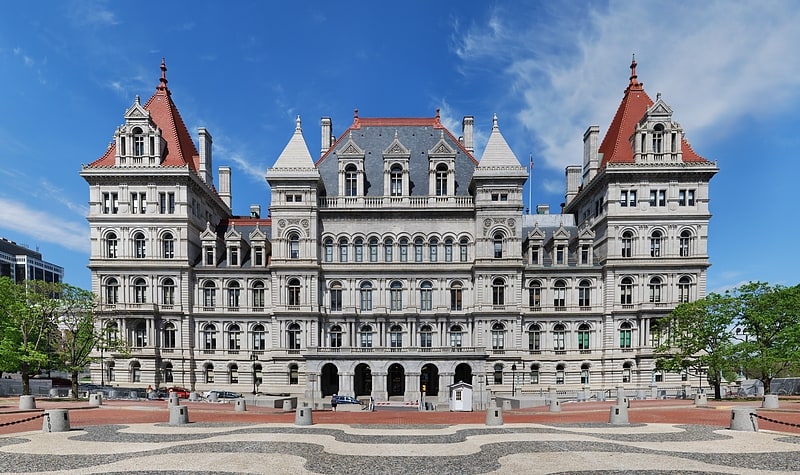
Grand government building. The New York State Capitol, the seat of the New York State government, is located in Albany, the capital city of the U.S. state of New York. The capitol building is part of the Empire State Plaza complex on State Street in Capitol Park. Housing the New York State Legislature, the building was completed in 1899 at a cost of US$25 million, making it the most expensive government building of its time. It was listed on the National Register of Historic Places in 1971, then included as a contributing property when the Lafayette Park Historic District was listed in 1978. The New York State Capitol was declared a National Historic Landmark in 1979.[1]
Address: State St., 12207 Albany
Times Union Center
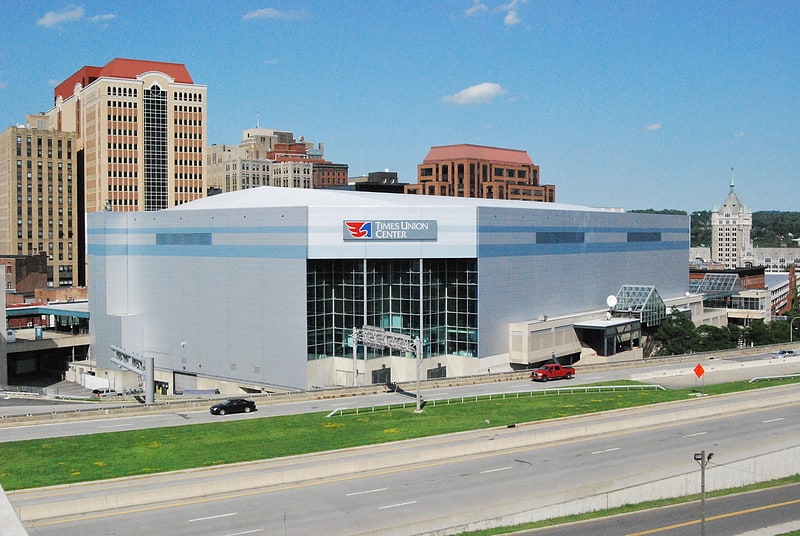
Indoor arena in Albany, New York. The MVP Arena is an indoor arena located in Albany, New York. It is configurable and can accommodate from 6,000 to 17,500 people, with a maximum seating capacity of 15,500 for sporting events.
The building, designed by Crozier Associates and engineered by Clough Harbour & Associates, was built by Beltrone/MLB at a cost of $69.4 million.[2]
Address: Albany, 51 South Pearl Street
Statue of Philip Schuyler

Statue by J. Massey Rhind. A statue of Philip Schuyler by J. Massey Rhind is installed outside Albany City Hall in Albany, New York, United States. The memorial is slated for removal, as of June 2020.[3]
The Egg Building
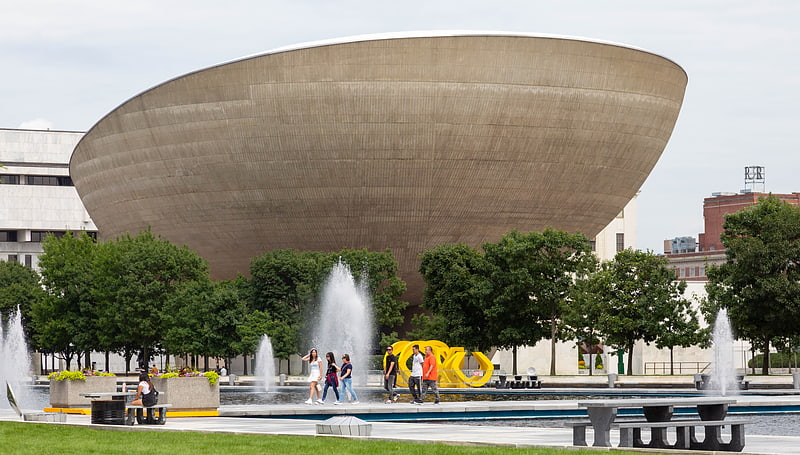
Theatre in Albany, New York. The Egg is a performing arts venue in Albany, New York. Named for its shape, the building was designed by Harrison & Abramovitz as part of the Empire State Plaza project, and built between 1966 and 1978. It is located in the northeast corner of the Plaza. It has become an icon of New York's Capital District due to its unusual shape and central location. The New York State Office of General Services maintains the Egg. The Nelson A. Rockefeller Empire State Plaza Performing Arts Center Corporation is a New York state public-benefit corporation that was created in 1979 to manage the performing arts facility in the Empire State Plaza. The Ellen Sinopoli Dance Company, a modern dance performing arts group, has been the resident company at the Egg for 28 years.[4]
New York State Fallen Firefighters Memorial
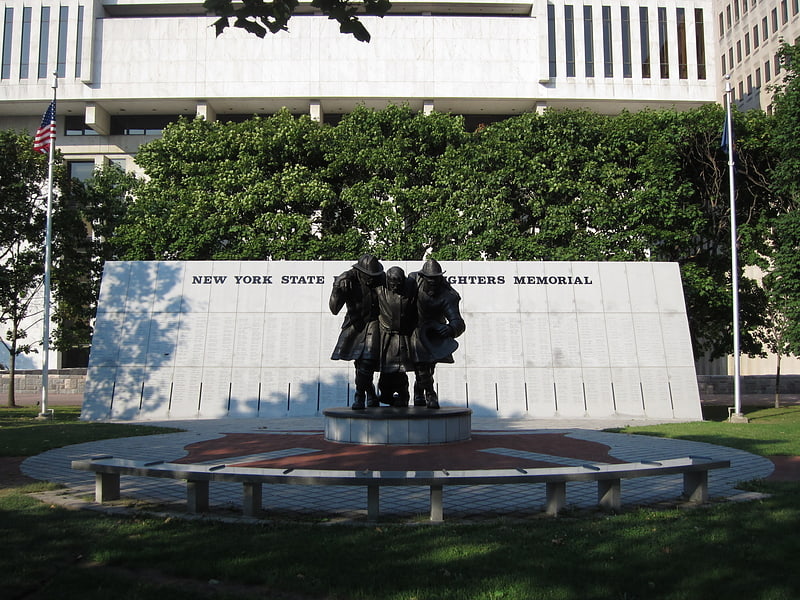
Memorial park in Albany, New York. The New York State Fallen Firefighters Memorial in Albany, New York is dedicated to the New York firefighters who have died in the line of duty. Governor of New York George Pataki officially dedicated the memorial on October 5, 1998. It features a 54-foot by 15-foot gray granite wall, with 2,312 names permanently etched into the stone. In front of the wall stands a 10-foot high dark bronze sculpture of two firefighters rescuing an injured colleague created by New York sculptor Robert Eccleston. The sculpture rests on a paved plaza with charcoal and red bricks forming a Maltese Cross. The Memorial stands on the northeast side of the Empire State Plaza in the park-like area bordered by Norway maples. It is easily accessible to the hundreds of thousand of visitors who travel to the New York State Capitol and Plaza each year.
The Fallen Firefighters Memorial Ceremony is held each year during national Fire Prevention Week.[5]
Albany City Hall
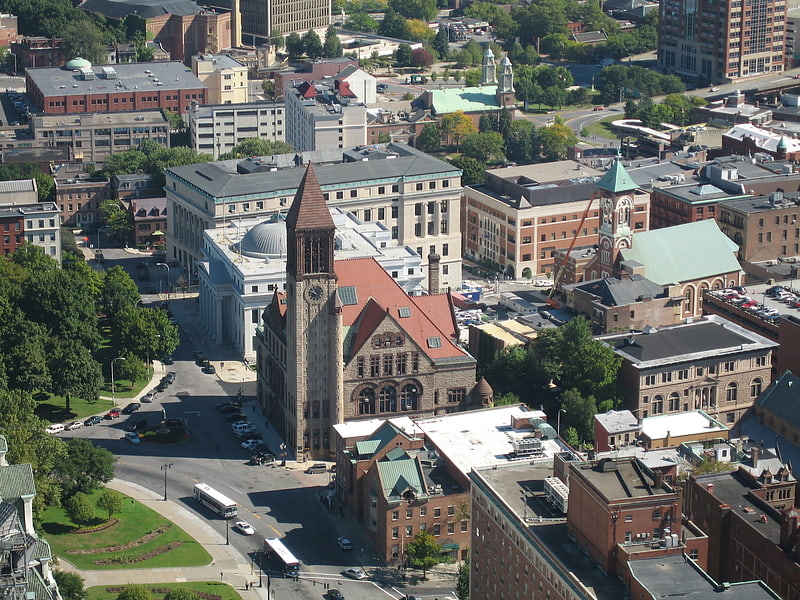
Building in Albany, New York. Albany City Hall is the seat of government of the city of Albany, New York, United States. It houses the office of the mayor, the Common Council chamber, the city and traffic courts, as well as other city services. The present building was designed by Henry Hobson Richardson in the Romanesque style and opened in 1883 at 24 Eagle Street, between Corning Place and Pine Street. It is a rectangular three-and-a-half-story building with a 202-foot-tall tower at its southwest corner. The tower contains one of the few municipal carillons in the country, dedicated in 1927, with 49 bells.
Albany's first city hall was the Stadt Huys (Dutch for "city hall"); sometimes written Stadt Huis), built by the Dutch at what is now the intersection of Broadway and Hudson Avenue, probably in the 1660s, though possibly earlier. It was probably replaced around 1740 with a larger Stadt Huys. In 1754, it was the site of the Albany Congress, where Benjamin Franklin presented the Albany Plan of Union, the first proposal to unite the British American colonies. After the Revolution brought independence, Albany was declared the state capital in 1797 and the state legislature met in city hall. In 1809 the Legislature opened the first state capitol and Albany's government moved in with it. Two decades later, the city purchased a plot of land at the eastern end of Washington Avenue, across Eagle Street from the capitol and moved its government into a new city hall designed by Philip Hooker that opened in 1832.
In 1880, Hooker's building was destroyed by fire and a new design by Richardson was commissioned. The cornerstone was laid by the local Masonic fraternity in 1881; the building was completed and opened two years later. Because of budget restrictions the original interior was simply designed, consisting chiefly of beaded board partitions, and thus not fireproof; it was entirely rebuilt in 1916-18 from designs by Albany architects Ogden & Gander. The city hall remains essentially as altered at that time, and the exterior is considered one of Richardson's finest works. The building was added to the National Register of Historic Places (NRHP) in 1972; it is also a contributing property to the Lafayette Park Historic District, listed six years later.[6]
Address: 24 Eagle St, 12207-1907 Albany
Washington Park
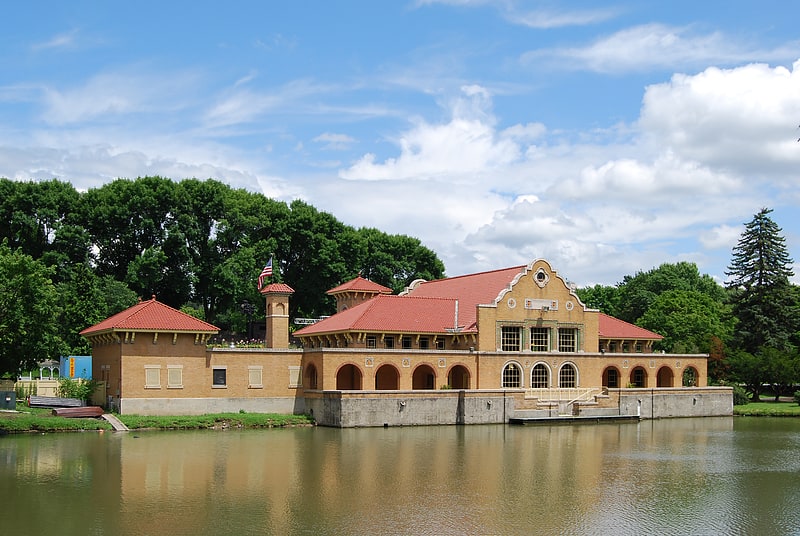
Washington Park in Albany, New York is the city's premier park and the site of many festivals and gatherings. As public property it dates back to the city charter in 1686, and has seen many uses including that of gunpowder storage, square/parade grounds, and cemetery. The park is often mistaken as being designed by Frederick Law Olmsted, as it incorporate many of the philosophical ideals used by Olmsted when he designed Central Park in Manhattan. The park is about 81 acres in size with the 5.2-acre Washington Park Lake, a roughly 1,600-foot-long and 140-foot-wide lake, in the southwestern corner.
Not only is the park historic, but so is the mostly residential surrounding neighborhood. Many architectural works line the streets facing the park, designed by some of the most famous architects of the late 19th century, including Henry Hobson Richardson. At least two governors of New York lived in buildings facing Washington Park outside of their term in office. Due to the historical and architectural significance of the park and neighborhood both were included in 1972 as the Washington Park Historic District; and in 1998 the park was named one of the nation's 100 most important parks by the American Association of Architects. In 2008 Boston-based composer Peter Child wrote an orchestral piece inspired by the park, entitled Washington Park.[7]
Address: Madison Ave and Willet St, 12210 Albany
New York State Museum
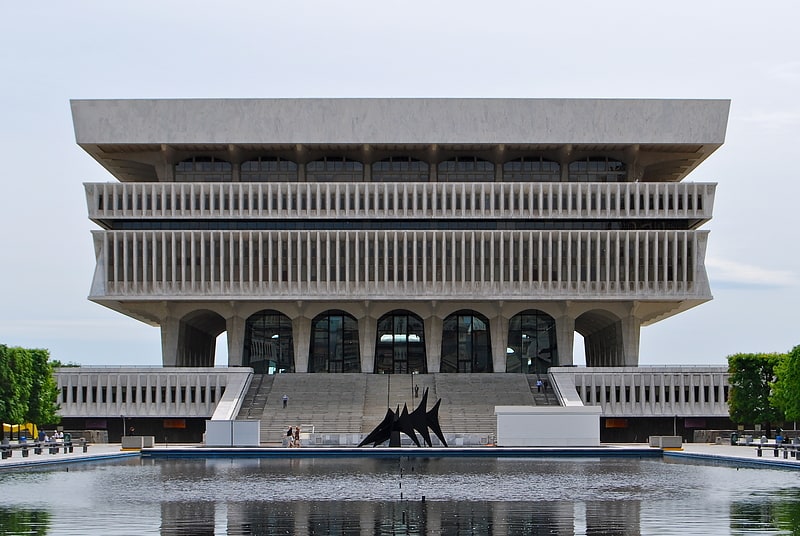
State story told through exhibits and art. The New York State Museum is a research-backed institution in Albany, New York, United States. It is located on Madison Avenue, attached to the south side of the Empire State Plaza, facing onto the plaza and towards the New York State Capitol. The museum houses art, artifacts, and ecofacts that reflect New York’s cultural, natural, and geological development. Operated by the New York State Education Department's Office of Cultural Education, it is the oldest and largest state museum in the US. Formerly located in the State Education Building, the museum now occupies the first four floors of the Cultural Education Center, a ten-story, 1,500,000-square-foot building that also houses the New York State Archives and New York State Library.
In 2020, the COVID-19 pandemic forced the NYSM, State Archives, and State Library to close temporarily, with museum employees continuing to work behind the scenes, offering virtual programming and online exhibitions. The Museum reopened to the public with reduced hours and days of operation and some exhibits still unopened on May 17, 2021.[8]
Address: Empire State Plaza, 12230 Albany
Empire State Plaza
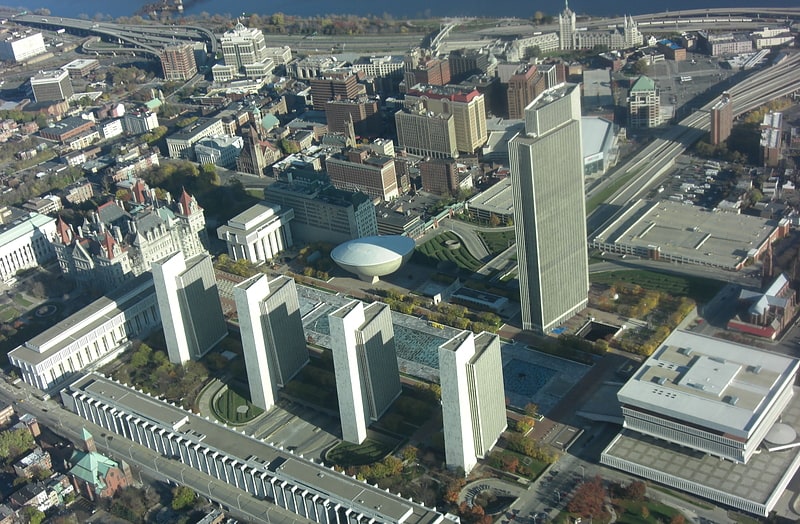
Building complex in Albany, New York. The Governor Nelson A. Rockefeller Empire State Plaza is a complex of several state government buildings in downtown Albany, New York.
The complex was built between 1965 and 1976 at an estimated total cost of $2 billion. It houses several departments of the New York State administration and is integrated with the New York State Capitol, completed in 1899, which houses the state legislature. Among the offices at the plaza are the Department of Health and the Biggs Laboratory of the Wadsworth Center. The Empire State Art Collection, a major public collection of 1960s and 1970s monumental abstract artworks, is on permanent display throughout the site. The New York State Office of General Services maintains the plaza. The Nelson A. Rockefeller Empire State Plaza Performing Arts Center Corporation is a New York state public-benefit corporation that was created in 1979 to manage the performing arts facility in the plaza.[9]
Address: Albany, Between Madison Avenue and State Street, and Swan Street and Eagle Street
Schuyler Mansion
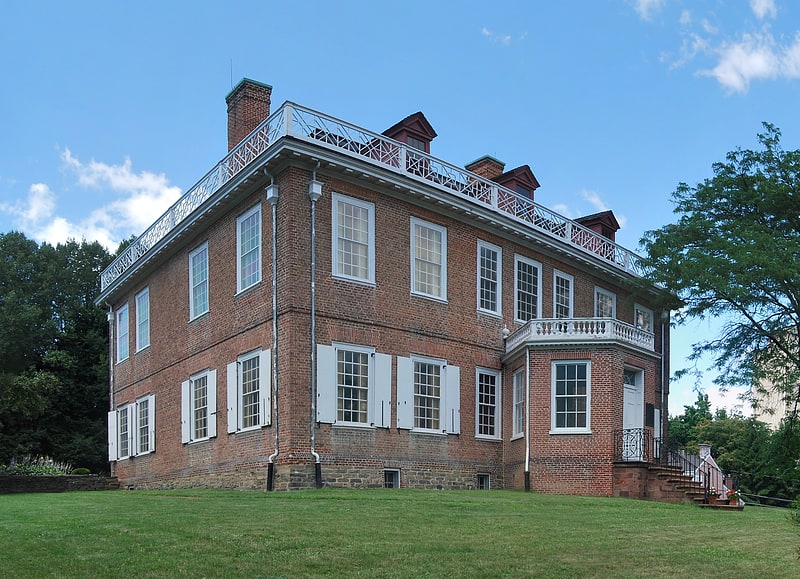
Museum in Albany, New York. Schuyler Mansion is a historic house at 32 Catherine Street in Albany, New York, United States. The brick mansion is now a museum and an official National Historic Landmark. It was constructed from 1761 to 1765 for Philip Schuyler, later a general in the Continental Army and early U.S. Senator, who resided there from 1763 until his death in 1804. It was declared a National Historic Landmark on December 24, 1967. It is also a contributing property to the South End–Groesbeckville Historic District, listed on the National Register of Historic Places in 1984.[10]
Address: 32 Catherine St, 12202-1605 Albany
Cathedral of the Immaculate Conception
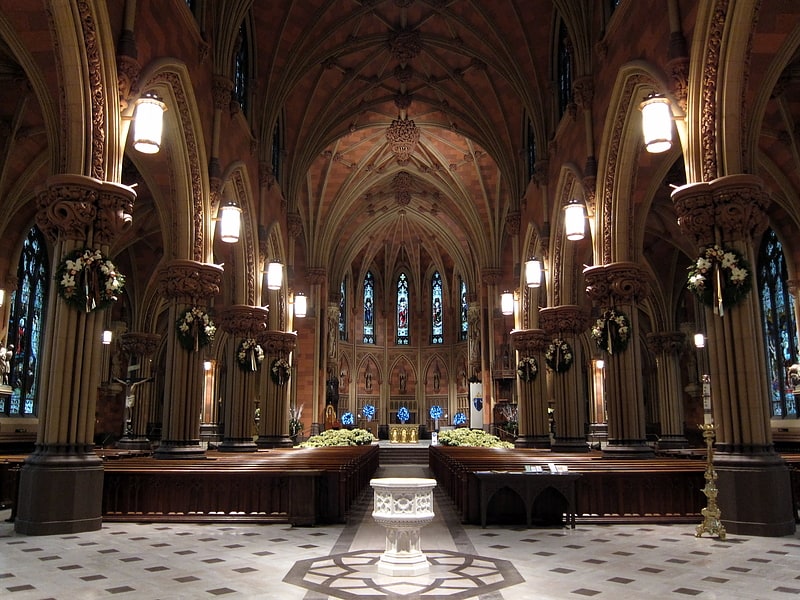
Catholic cathedral in Albany, New York. The Cathedral of the Immaculate Conception is a Roman Catholic church near the Mansion District in Albany, New York, United States. Built in the period of the 1848-1852, it is the mother church of the Diocese of Albany. In 1976 it was listed on the National Register of Historic Places.
It has several claims to architectural and ecclesiastical history. Designed by Irish American architect Patrick Keely to accommodate Albany's growing population of Catholic immigrants, it is the second-oldest cathedral in the state, after St. Patrick's Cathedral in New York City. It is also the third oldest Catholic cathedral in the United States, and the first American Catholic cathedral in the Neo-Gothic architectural style.
The interior features the original stained glass windows, imported from England, and award-winning Stations of the Cross statuary. When completed, it was the tallest building in Albany. It has hosted visits by cardinals and leaders of other faiths, including one Archbishop of Canterbury, and the weddings of two Catholic governors' daughters. In 1986 it hosted the first-ever service of forgiveness between Catholics and Jews on Palm Sunday, an event commemorated by a sculpture outside the building.
Construction of the cathedral, at the behest of the diocese's first bishop, John McCloskey, took four years. Its south tower took 40, and it was not consecrated until its 50th anniversary in 1902. The construction of Empire State Plaza, the nearby New York state government complex, threatened the cathedral in the 1960s when it required the demolition of most of the surrounding neighborhood. It has been through several renovations in its history, including a $30 million restoration early in the 21st century.[11]
Address: 125 Eagle St, 12202-1718 Albany
Erastus Corning Tower
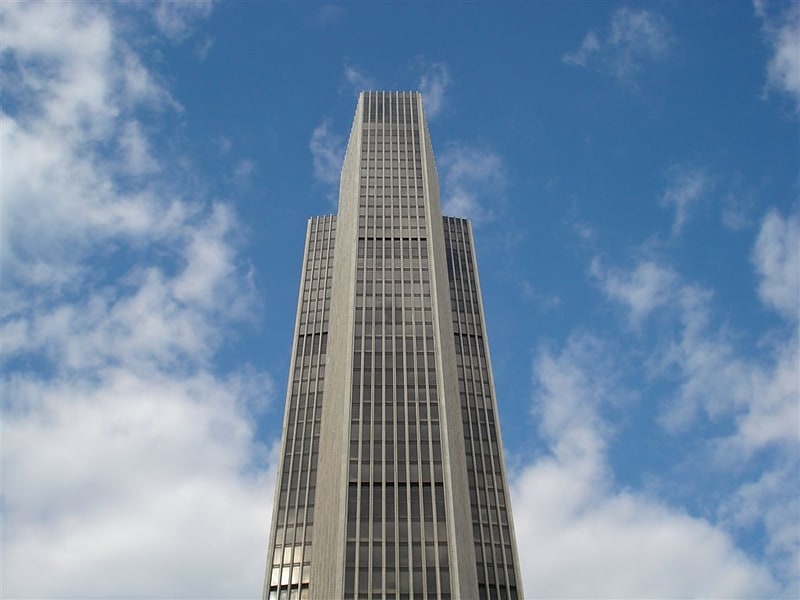
Skyscraper. The Erastus Corning Tower, also known as the Mayor Erastus Corning 2nd Tower or simply the Corning Tower, is a skyscraper located in downtown Albany, New York. Completed in 1973 and sided with Vermont Pearl marble and glass, the state office building is part of the Empire State Plaza. At 589 feet and 44 stories in height, it is the tallest skyscraper in the state of New York outside of New York City. Erastus Corning 2nd, the building's namesake, was the mayor of Albany for over 40 years from 1941 to 1983. The tower was dedicated to him in March 1983 during his hospitalization. Before that dedication, it was known as the "Tower Building".
The Corning Tower houses the New York State Department of Health and the New York State Office of General Services. Two New York State Department of Transportation traffic cameras are located on the building to monitor nearby traffic conditions. From 2000 to 2004, it was the tallest structure in the World Almanac's list of "Other Tall Buildings in North American Cities".[12]
Address: 5 Empire State Plz, 12223-1500 Albany
Cathedral of All Saints
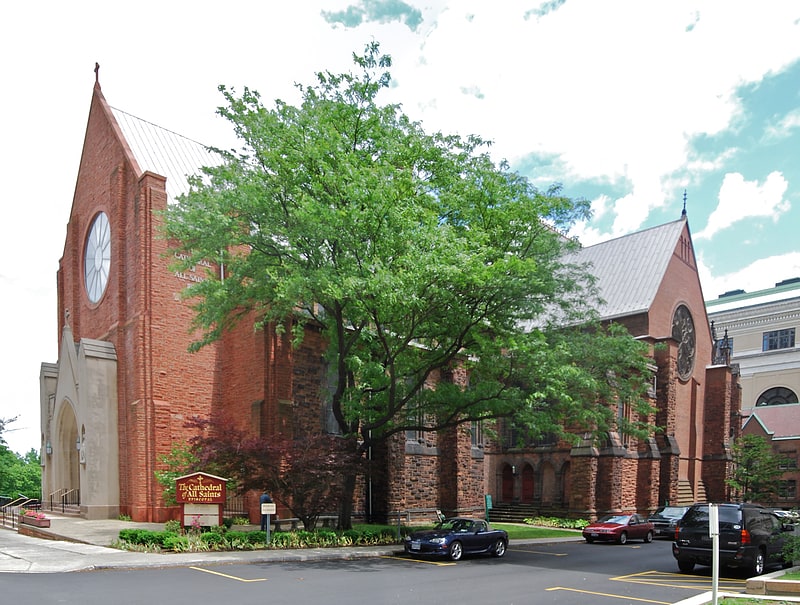
Episcopal church in Albany, New York. The Cathedral of All Saints, Albany, New York, is located on Elk Street in central Albany, New York, United States. It is the central church of the Episcopal Diocese of Albany and the seat of the Episcopal Bishop of Albany. Built in the 1880s in the Gothic style and designed by Robert W. Gibson, it was listed on the National Register of Historic Places in 1974. Previously it had been recognized as a contributing property to the Lafayette Park Historic District, listed on the Register in 1970.
It was the first Episcopal Cathedral church in the United States to be built expressly as such, rather than a local parish being chosen to serve as the church of a bishop, and for that reason, it is also called the Pioneer Cathedral. The church was unable to complete the cathedral and the large planned complex in the early 20th century. Because the commissioner of the State Education Department had his headquarters built on the remainder of the block, the remainder of the cathedral will never be completed. Some foundations for planned expansions remain, however, for instance, for spires.[13]
Address: 62 S Swan St, Albany
First Congregational Church of Albany
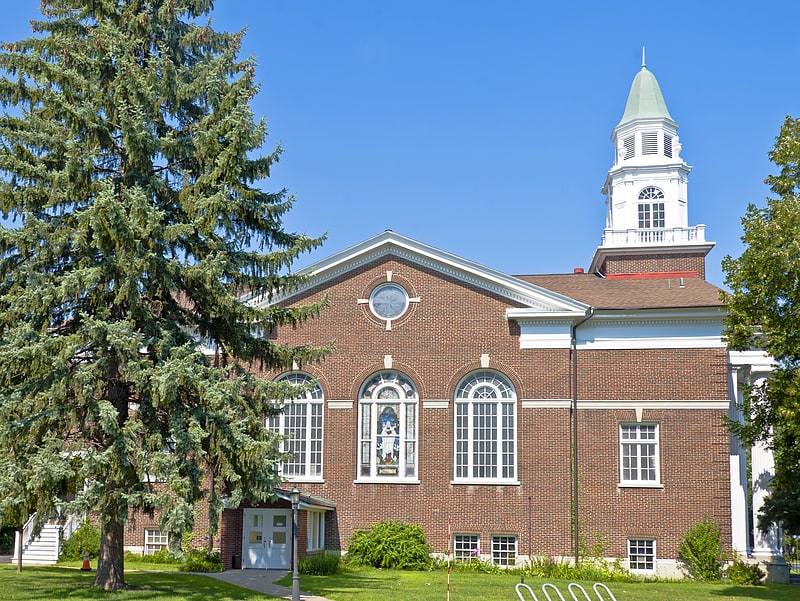
Congregational church in Albany, New York. The First Congregational Church of Albany, also known as The Ray Palmer Memorial, is located on Quail Street in the Woodlawn section of Albany, New York, United States. It is a brick building in the Colonial Revival architectural style built in the 1910s and expanded half a century later. In 2014 it was listed on the National Register of Historic Places.
Within two years of its establishment in 1850 the congregation hosted the Albany Convention, a gathering which helped Congregationalism develop a nationwide reach. The Rev. Ray Palmer, later known for his hymns, guided the church through its early years, when it was located in downtown Albany, first in a former Presbyterian church and later in its own building. In the early 20th century, the church followed its congregants in moving out towards the more suburban areas of Albany being developed along the city's trolley lines.
The Fuller & Robinson Company designed the present church, following the Wren–Gibbs tradition. It was the first Colonial Revival church in the city, attracting much local media attention. Construction was delayed by the onset of World War I; it was formally dedicated to Ray Palmer in 1919.
As one of the first churches to establish itself in those areas, it formed a social center of the new neighborhood. After World War II, plans went ahead to build a Sunday school wing intended for the original church. It was completed, in an architecturally sympathetic modernist style, by the early 1960s. It continues to have an active congregation, affiliated with both the United Church of Christ and National Association of Congregational Christian Churches.[14]
Address: 405 Quail St, Albany
Albany Institute of History & Art
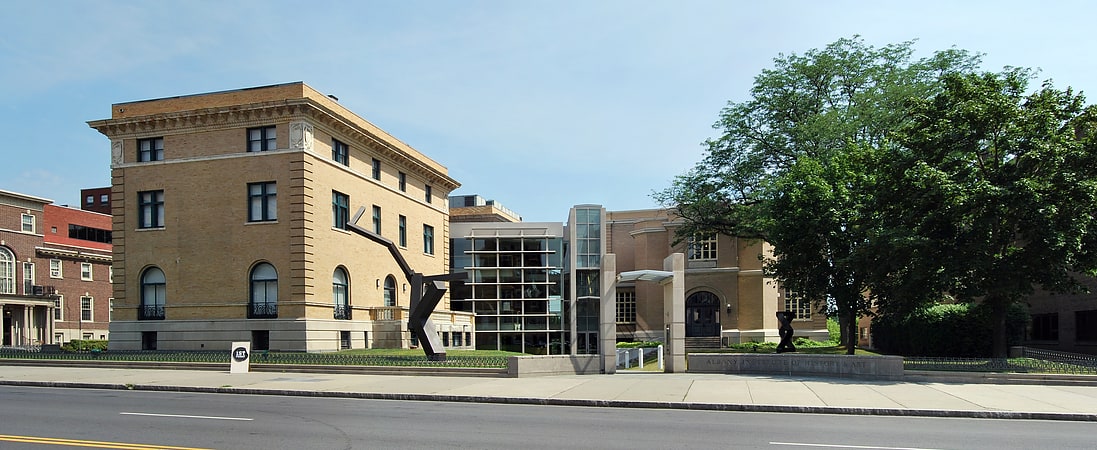
The Albany Institute of History & Art is a museum in Albany, New York, United States, "dedicated to collecting, preserving, interpreting and promoting interest in the history, art, and culture of Albany and the Upper Hudson Valley region". It is located on Washington Avenue in downtown Albany. Founded in 1791, it is among the oldest museums in the United States.
Several other institutions have merged over time to become today's Albany Institute. The earliest were learned societies devoted to the natural sciences, and for a time it was the state legislature's informal advisory body on agriculture. Robert R. Livingston was the first president. Joseph Henry delivered his first paper on electromagnetism to the Institute. Its collections of animal, vegetable and mineral specimens from state surveys eventually became the foundations of the New York State Museum. Later in the century it became more focused on the humanities, and eventually merged with the Albany Historical and Art Society. It has had its present name since 1926. Over the course of the 20th century it has become more firmly established as a regional art museum.
The institute's three-building complex includes the late 19th-century Rice Building, the only freestanding Beaux-Arts mansion in the city, designed by Richard Morris Hunt and donated to the institute by one of its former benefactors. Its main building is a 1920s Classical Revival structure designed by local architect Marcus T. Reynolds. A more modern glass structure connects the two. The original two buildings were listed on the National Register of Historic Places in 1976. At the beginning of the 21st century, the institute completed an extensive renovation in which the entrance building was constructed and new climate-controlled storage space for the collections was built.[15]
Address: 125 Washington Ave, 12210-2202 Albany
Palace Theatre
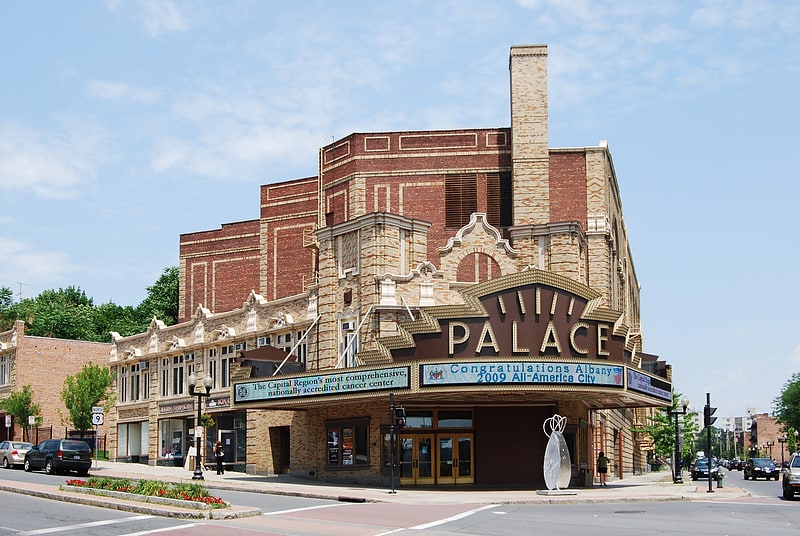
Theatre in Albany, New York. The Palace Theatre is an entertainment venue in downtown Albany, New York, located on the corner of Clinton Avenue and North Pearl Street. The theatre is operated by the Palace Performing Arts Center, Inc - a 501 non-profit organization. Established in 1984 and incorporated as a not-for-profit corporation in 1989, the Palace Performing Arts Center, Inc. was created to operate the theatre and utilize its full potential as a cultural and entertainment center in Albany.
It continues its tradition of hosting the finest in live entertainment with over 150 events annually, from public performances such as concerts, world-class ballet and dance, Broadway, educational programs, live comedy and classic movies to private events such as weddings, dance competitions, corporate events, and graduations. Home to the Grammy Award-winning Albany Symphony Orchestra, artists as diverse as the Rolling Stones, Jerry Seinfeld, Bruce Springsteen, Roy Orbison, Tony Bennett, and Melissa Etheridge have graced the Palace stage over the years.
Designed by John Eberson, one of the world's foremost theatre architect of the time and well noted for his atmospheric theatre designs. The Radio Keith Orpheum (RKO) owned facility spared no expense in its design and boasted an ornate Austrian Baroque design with "atmospheric" elements in the auditorium. Though many changes have taken place since its opening, the Palace has retained most of its original design features, including an impressive brass chandelier in the main lobby, original murals painted by Hungarian artists Andrew Karoly and Louis Szanto and plaster beams in the fore-lobby painted to resemble carved wood. In 1979 it was listed on the National Register of Historic Places. Nine years later it was declared a contributing property to the Clinton Avenue Historic District.[16]
Address: Albany, 19 Clinton Ave, Albany, New York 12207-2211
St. Peter's Episcopal Church
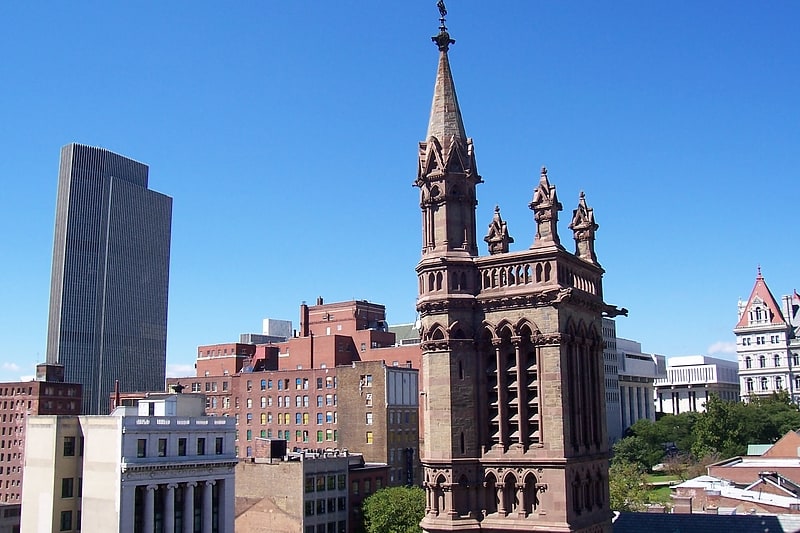
Episcopal church in Albany, New York. St. Peter's Episcopal Church, also known as St. Peter's Church, is located in downtown Albany, New York, United States. It was designed in the mid-19th century by Richard Upjohn and his son Richard M. Upjohn in the French Gothic Revival architectural style. It was listed on the National Register of Historic Places in 1972, and designated a National Historic Landmark eight years later. It is also a contributing property to the Downtown Albany Historic District.
The church was established at the behest of Queen Anne in 1715. The church still has a silver communion service set given to it by her. It was the first Anglican congregation north of New York City and west of the Hudson River.
A building was erected shortly after the church was established, housing it for the rest of the 18th century. In 1758, George Howe, 3rd Viscount Howe, was buried here after his death leading an attempt to recapture Fort Ticonderoga during the French and Indian War. His grave remains in the current church, making him the only British peer buried in the United States.
The original building was replaced in 1803. That building yielded to the current structure almost 60 years later, with the tower making it complete in 1876. It is often considered one of the elder Upjohn's best-known works, although his son was largely responsible for designing the tower, its most distinctive feature. The interior includes some original Clayton & Bell stained glass windows and sculpture by Louis Saint-Gaudens.[17]
Address: 107 State St, Albany
Crailo State Historic Site
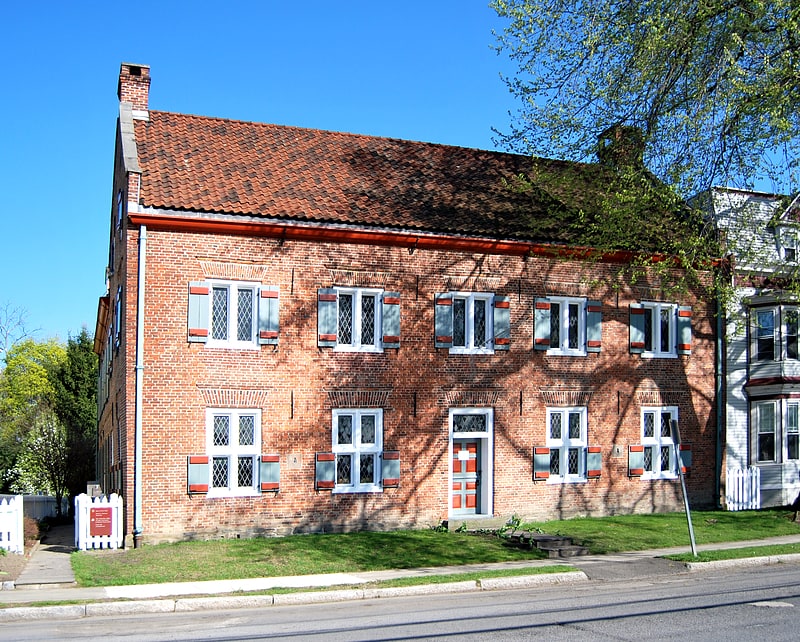
Manor house. The Crailo State Historic Site is a historic, fortified brick manor house in Rensselaer, New York which was built in 1707. The word Crailo is derived from kraaien bos and refers to Kiliaen van Rensselaer's estate in Huizen, Holland, which is also named "Crailo". Fort Crailo is listed on the National Register of Historic Places.[18]
Address: 9 1/2 Riverside Ave, 12144-2927 Rensselaer (Rensselaer)
Ten Broeck Mansion
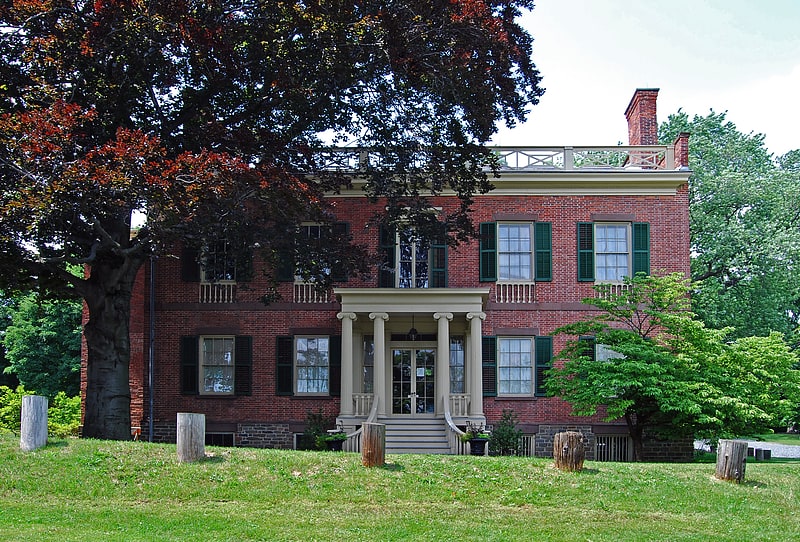
Historical place museum in Albany, New York. The Ten Broeck Mansion in Albany, New York was built in 1797. It was listed on the National Register of Historic Places in 1971. A decade later it was included as a contributing property to the Arbor Hill Historic District–Ten Broeck Triangle when that neighborhood was listed on the Register.[19]
Address: 9 Ten Broeck Pl, 12210-2524 Albany
First Church in Albany
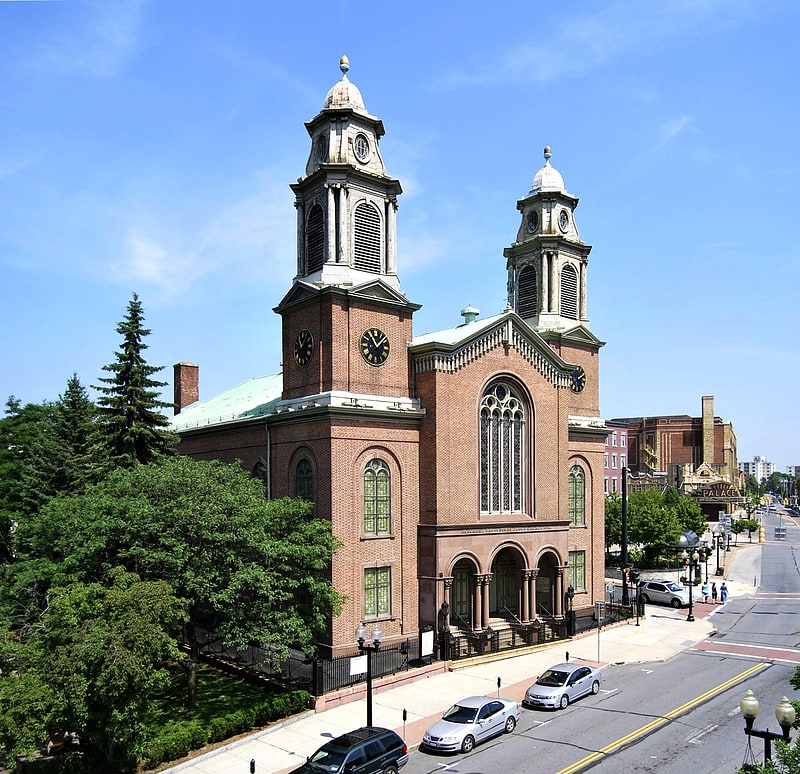
Church in Albany, New York. The First Reformed Church, also known as First Church in Albany or North Dutch Church, is located at North Pearl and Orange streets in Albany, New York, United States. It is a member congregation of the Reformed Church in America. The building was designed by Philip Hooker and built in the period of 1797–1799. It was listed on the National Register of Historic Places in 1974.
It was established in 1642 to serve the Dutch inhabitants of Fort Orange, the adjacent village of Beverwyck, and the patroonship of Rensselaerswyck in general. It is the second oldest congregation in the state of New York, and the oldest upstate. The current church, designed by Philip Hooker, is the fourth building and the oldest church in Albany. The pulpit was imported from the Netherlands in 1656 and is the oldest pulpit in the United States.
Shortly after construction, a memorial service was held for Alexander Hamilton. Theodore Roosevelt attended services here while Governor, and Queen Wilhelmina visited the church during its 300th anniversary year. The church has been through many renovations since it was built.[20]
Watervliet Shaker Historic District

Watervliet Shaker Historic District, in Colonie, New York, is the site of the first Shaker community. It was established in 1776. The primary Shaker community, the Mount Lebanon Shaker Society, was started a bit later. Watervliet's historic 1848 Shaker meetinghouse has been restored and is used for public events, such as concerts.
The founder of the Shakers, Mother Ann Lee, is buried here.
It was listed on the National Register of Historic Places in 1973, and the listing was expanded later in the same year. Albany International Airport was constructed on the community's herb garden.
At the time it was founded it was located in the Town of Watervliet, which went out of existence in 1896. Since then it has been in the Town of Colonie, not even close to the boundary of the modern City of Watervliet.[21]
Historic Cherry Hill
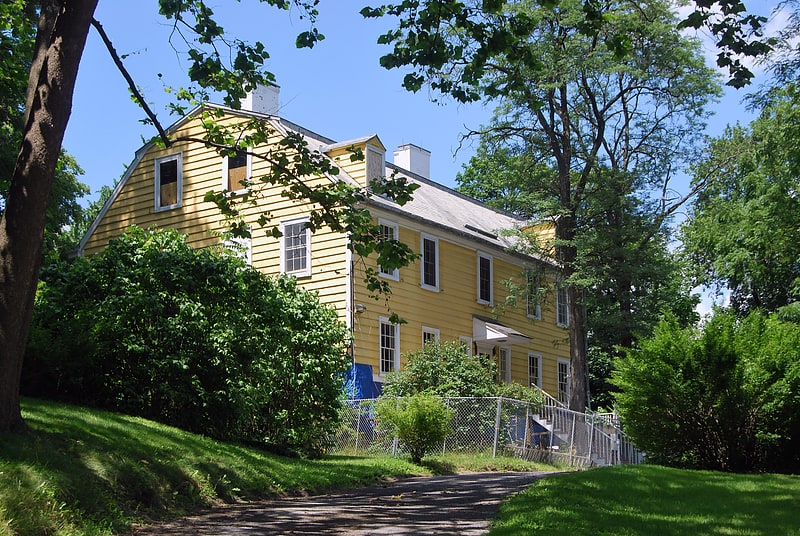
Historical place museum in Albany, New York. Cherry Hill is a historic house located on South Pearl Street in Albany, New York, United States. It is a timber frame structure dating to the late 18th century. In 1971 it was listed on the National Register of Historic Places, one of the first properties in the city to receive that designation.
It was built by Colonel Philip Kiliaen van Rensselaer for his bride Maria Sanders, granddaughter of Peter Schuyler. During the early 19th century, it was the home of Solomon van Rensselaer, who served in Congress and several local governmental positions. It eventually became the manor house of a large farm. Within several years during the 1820s it was both accommodations for the Marquis de Lafayette on his return visit to the U.S. and the scene of a murder which led to the last public hanging in Albany following a controversial trial. It is reputedly haunted.
Van Rensselaer's descendants lived there for nearly two centuries, preserving intact not only the original interior finishes but also its furniture, portraits, kitchenware and family documents. Since their tenure, it has been operated as a historic house museum by the Historic Cherry Hill Association. It is currently undergoing an extensive restoration since the building was in danger of collapsing under the weight of its stored collections.[22]
Address: 523 1/2 S Pearl St, 12202-1111 Albany
Capital Repertory Theatre

Theatre in Albany, New York. Capital Repertory Theatre is a 309-seat professional regional theatre in Albany, New York. Capital Rep is the only theatre in the Capital District in the League of Resident Theatres. The theatre operates under regulations dictated by Actors' Equity Association. The theatre relocated to its new home at 251 N. Pearl St in Albany, New York in 2021.
The theatre is one of three venues in the Proctors Collaborative, the others being Universal Preservation Hall in Saratoga and Proctors in Schenectady.
The theatre's predecessor was Lexington Conservatory Theatre in Lexington, New York, founded in 1976 by Oakley Hall III. After Hall was seriously injured and incapacitated in 1978, the company moved to Albany and became Capital Repertory Theatre.
The producing artistic director of Capital Rep is Maggie Mancinelli-Cahill.[23]
Address: 111 N Pearl St, 12207-2208 Albany
Albany Center Gallery
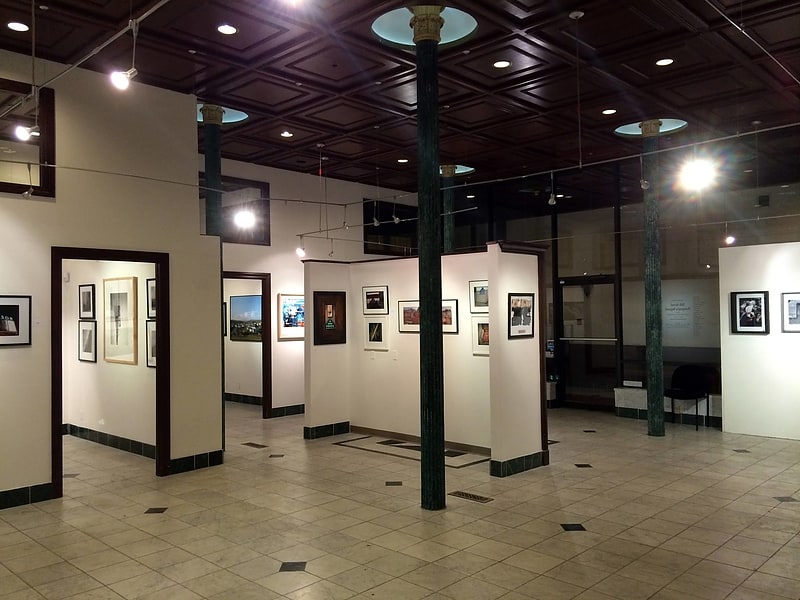
Art gallery in Albany, New York. Albany Center Gallery is a nonprofit art space located in downtown Albany, New York. Supported by city, state, corporate and foundation funds, as well as fundraisers, individual donations and memberships, the Gallery is dedicated to the exhibition of regional artists within a 100-mile radius of Albany, and building a strong, knowledgeable audience for the visual arts. Serving the art community and the general public, all of Albany Center Gallery's exhibitions, receptions, and artist interviews are free and open to the public. The gallery presents at least seven major exhibitions a year in the main gallery, including the Mohawk Hudson Regional Invitational, an annual exhibition featuring selected artists from the previous year's Artists of the Mohawk-Hudson Region exhibit.[24]
Address: 39 Columbia St, 12207-2824 Albany
Dunn Memorial Bridge
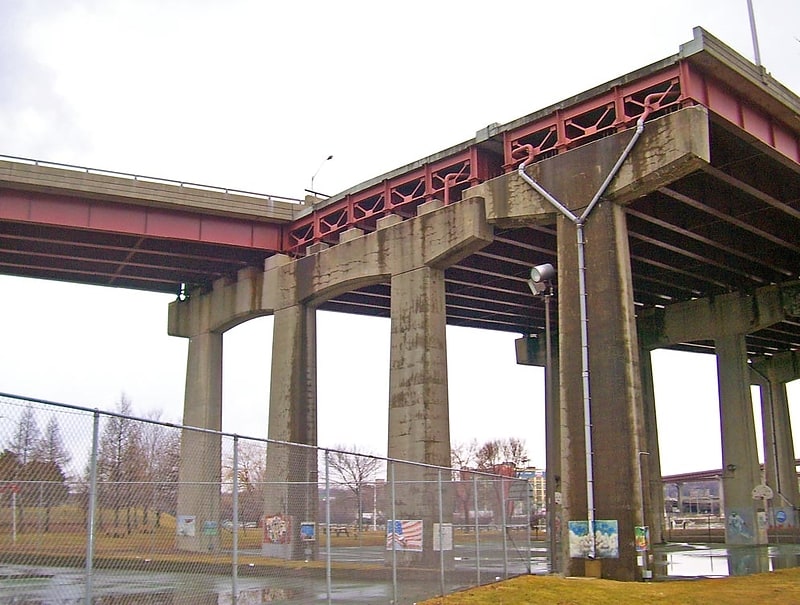
Girder bridge in Rensselaer, New York. The Dunn Memorial Bridge, officially known as the Private Parker F. Dunn Memorial Bridge, carries US 9 and US 20 across the Hudson River between Albany, New York and Rensselaer, New York.[25]
St. Andrew's Episcopal Church
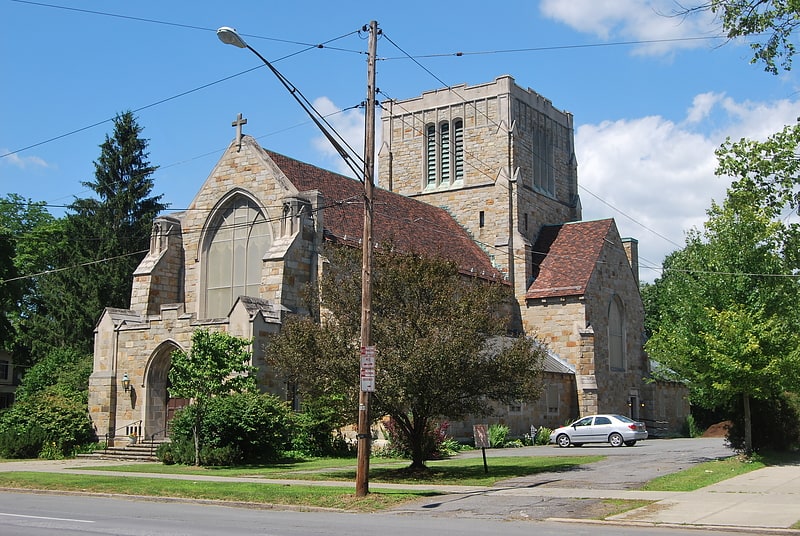
Building in Albany, New York. St. Andrew's Episcopal Church is located at North Main and Madison avenues in Albany, New York, United States. It is a complex of three buildings, centered on the church itself, a stone structure designed by architect Norman Sturgis in the Late Gothic Revival architectural style and built in 1930. In 2005 it was listed on the National Register of Historic Places.
The congregation was established by a downtown church, St. Paul's, from a neighborhood mission near the end of the 19th century. It was one of the first churches started in the suburban areas of the city, as it expanded away from its historic core. St. Andrew's soon built its own church (since demolished to make room for the current attached parish house) and established itself as a separate parish.
Sturgis' structure was meant to embody the ideals of his mentor, Ralph Adams Cram, which valued the English Gothic styles as ideal for Episcopal and Anglican worship since such buildings were where it had originally been practiced. Accordingly, it is modeled in part on St. Albans Abbey in Hertfordshire, England, and a Roman brick from that location was placed in the hyphen between the church and the parish hall. But it is not an exact copy, and Sturgis himself described it as "an attempt to express fundamental truths in a new way to tell an old, old story in new words". It is considered one of the best examples of the 20th-century Late Gothic Revival style in Albany.[26]
Address: 10 N Main Ave, Albany
Saint Joseph's Church
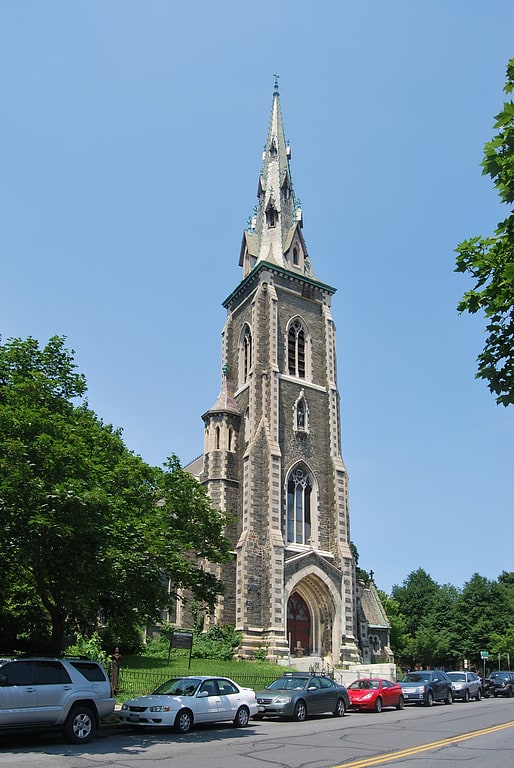
Church in Hidalgo County, Texas. St. Joseph's Church is a historic neo-gothic church edifice in the Ten Broeck Triangle section of Albany, New York's Arbor Hill neighborhood. The structure is considered a city landmark and an important part of the Albany skyline. The church closed in 1994. As of February 2019, it is owned by the City of Albany.[27]
Patroon Island Bridge
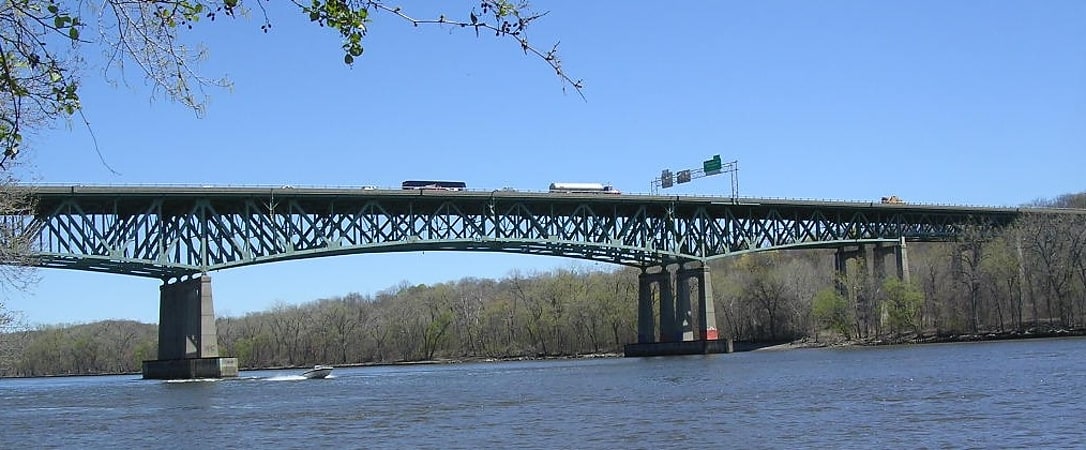
Truss bridge in Rensselaer, New York. The Patroon Island Bridge is a major crossing of the Hudson River in Albany, New York. The bridge carries Interstate 90, in the east-west direction, over the Hudson River between Albany and Rensselaer Counties.
It has been in service since 1968; however, some structural repairs were made in 1992. The bridge consists of ten spans. Seven spans are considered the main spans and consist of steel trusses and concrete decks. The other three spans are considered approach spans, which are supported by plate girders. The main span over the river-shipping channel is 375 feet (114 m) long and 89 feet (27 m) wide, and the overall bridge length is 1,795 feet (547 m). There is an estimated 60 feet (18 m) of clearance for shipping on the Hudson River below, which changes with the local tide. The bridge has an HS Inventory load rating of 35 short tons (31 long tons; 32 t), and is inspected annually. The average daily traffic count was 70,787 in 1998 with a 4.5 percent estimated traffic growth during the life of the bridge.
The bridge's design is similar to that of the Interstate 35W bridge in Minneapolis, MN, which collapsed during rush hour on August 1, 2007. This realization by New York State transportation officials prompted full-scale inspections of the state's major highway bridges, including the Patroon Island Bridge. Subsequently, the bridge was deemed safe for the time being, but would need substantial repairs and retrofitting in order to ensure motorist safety, and to extend its useful service life if replacement was found not to be a viable option in the near future. On May 31, 2016, the New York State Department of Transportation declared that it had completed a $148-million-dollar renovation and rebuild of the bridge.
The bridge's name comes from the former (Lower) Patroon Island that once existed adjacent to the bridge. A patroon was a proprietor of a tract of land in the 17th-century Dutch colony of New Netherland in North America.[28]
Dana Park
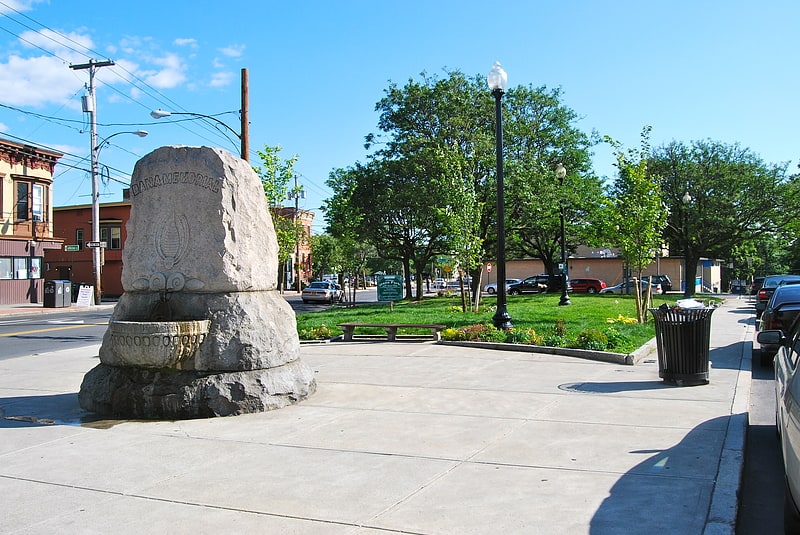
Park in Albany, New York. Dana Park is a small.2-acre urban park in Albany, New York and includes a memorial to James Dana which doubles as Albany's last remaining horse trough. It is located in the Y-intersection caused by Delaware Avenue to the east and Lark Street to the west, with the third leg of the triangle formed by Dana Avenue. Madison Avenue forms a five-point intersection with Lark Street and Delaware Avenue at the eastern end of the park. The park is important to several different neighborhoods, Hudson-Park, Park South, and Lark Street.[29]
Whipple Cast and Wrought Iron Bowstring Truss Bridge
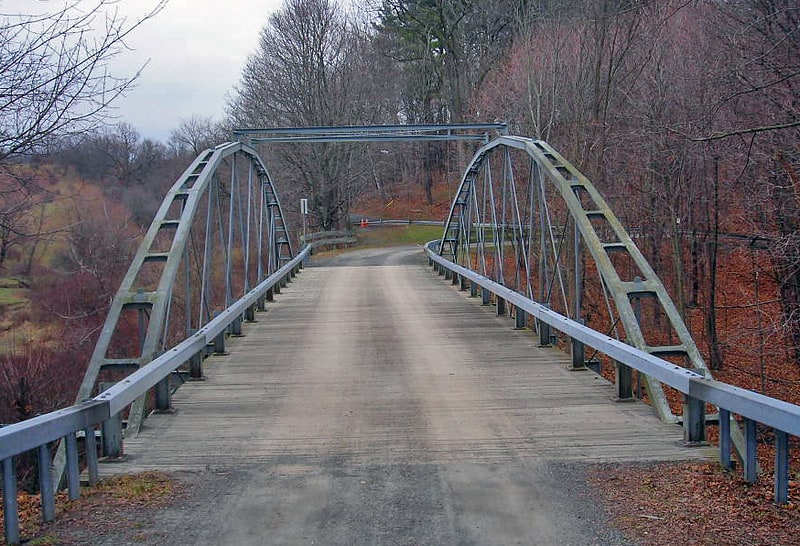
Truss bridge in Albany, New York. The Whipple Cast and Wrought Iron Bowstring Truss Bridge, is located near the entrance to Stevens Farm in southwestern Albany, New York, United States. It was built in 1867, but not moved to its present location until 1899. It is one of the oldest surviving iron bridges in the county, one of the few that use both cast and wrought iron and one of only two surviving examples of the Whipple bowstring truss type. In 1971 it was listed on the National Register of Historic Places, the only bridge in the city of Albany so far to be listed individually.
A Syracuse-based builder copied Squire Whipple's original bowstring truss design, the patent for which had expired by the time of its construction. Where it was originally located is not known; it is believed to have been somewhere west of the city, possibly in Schoharie County.
When the old Albany and Delaware Turnpike, today Delaware Avenue, was rerouted in 1899 to what is now Normanskill Drive, it was moved to its present location to make the farm more accessible from the main road. When Delaware was straightened out into what is today New York State Route 443 (NY 443), traffic on the bridge went down, allowing the bridge to remain in use, although only for cars. Today it is limited only to pedestrian use, and is closed in winter. The City of Albany approved a small-scale restoration project in 2012.[30]
USS Slater

USS Slater is a Cannon-class destroyer escort that served in the United States Navy and later in the Hellenic Navy. Following service during World War II, the ship was transferred to Greece and renamed Aetos. Decommissioned in 1991, the destroyer escort was returned to the United States.
USS Slater is now a museum ship on the Hudson River in Albany, New York, the only one of its kind afloat in the United States. As of 2020, fewer than 12 destroyer escorts survive, with Slater the only one in its wartime configuration. Slater was designated a National Historic Landmark on 2 March 2012.
USS Slater was struck by the Hudson River touring ship Dutch Apple on 10 September 2019. A mechanical issue aboard Dutch Apple was to blame for the collision.[31]
Address: Broadway and Quay Street, 12202 Albany
New York State Executive Mansion
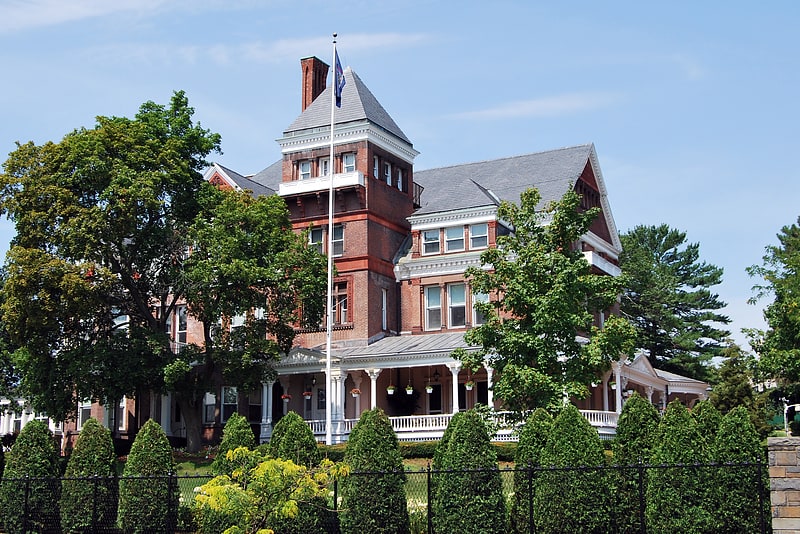
Historical landmark in Albany, New York. The New York State Executive Mansion is the official residence of the governor of New York. Located at 138 Eagle Street in Albany, New York, it has housed governors and their families since 1875.[32]
Address: 138 Eagle St, 12202-1719 Albany
Washington Park Lake
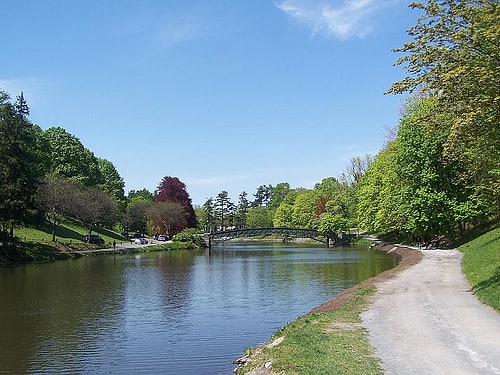
Body of water in New York State. Washington Park Lake is a body of water in Albany, New York located in the southwestern corner of Washington Park. It has a surface area of 5.2 acres and a mean depth of 6.6 feet. The deepest sections of the lake are just over 11 feet deep. The lake is roughly 1,600 feet long and 140 feet wide. Next to the lake is the Washington Park Lakehouse and an amphitheater where the Park Playhouse performs musicals in the summer. A wrought-iron pedestrian bridge spans the lake at its narrowest point. The footbridge over Washington Park Lake is the only remaining original structure in Washington Park. Erected over the lake in 1875 the lamps on the bridge were originally gas burning but were electrified in 1881. Ice skating is permitted on Washington Park Lake, though swimming is prohibited.[33]
Bleecker Park

Park in Albany, New York. Bleecker Park is a small.37-acre urban park in Albany, New York. The park is triangle-shaped, bounded by Madison Place to the south, Madison Avenue to the north, and Eagle Street to the west. The Cathedral of Immaculate Conception is across Eagle Street from the park, while Madison Place, which is only one block-long, consists of rowhouses primarily in High Gothic and Italianate architecture, built in the mid-to-late-19th century. Across from the park on Madison Street is the Empire State Plaza East Parking Garage, built in 1999/2000. The park features the oldest fountain in the city which is surrounded by a small circular garden, two circular beds are also in the park and each feature a shrub surrounded flowers, these small gardens make Bleecker Park "a most charming and restrained Victorian public garden" according to an article in the Albany Times Union.[34]
Hudson River Way
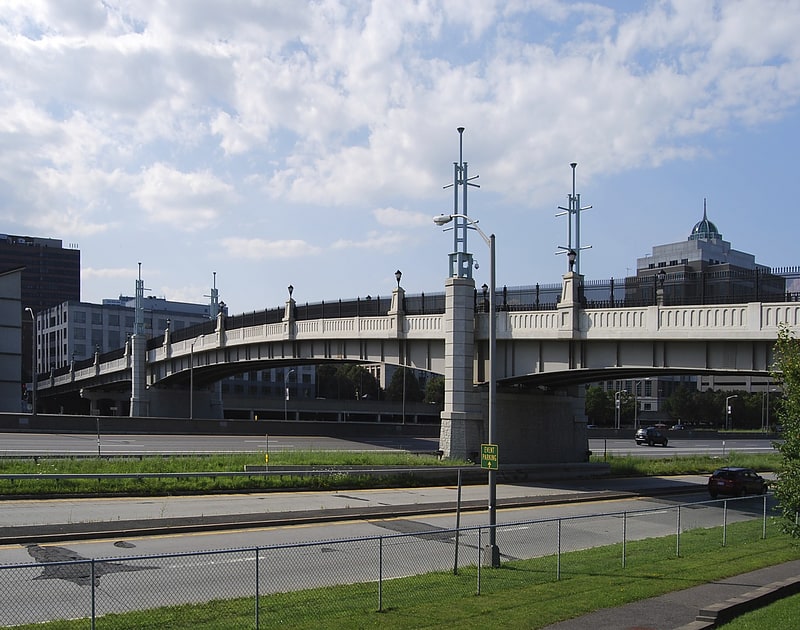
Pedestrian bridge. The Hudson River Way is a 2002 pedestrian bridge that links Broadway in downtown Albany, New York with the Corning Preserve on the bank of the Hudson River. The bridge crosses Interstate 787.[35]